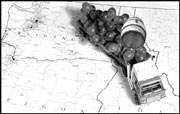One thing there’s no shortage of in the little world of Washington wine: experts. Salespersons, critics, winemakers, grape growers, PR people—they’ll talk your ear off about how wonderful everything is: how this year’s wine-grape crop will top 118,000 tons, up 16 percent over last year; and how in-state wine sales are up 17 percent, with sales to the rest of the U.S. and world up sharply, too.
It’s all true, but it’s not the whole story; for that you have to turn to a guy who’s not even in the wine business at present and who’s never squeezed a grape in his life except for fun. Allen Shoup was president of U.S. Tobacco’s Washington wine subsidiary Stimson Lane for 18 years before his retirement in 2000, and he continues to believe the industry has a bright future—he just doesn’t think that growth in output and acreage alone point the way there.
“We have to face a basic fact: America is not a wine-drinking country,” Shoup says. “Per capita, Americans drink two and a half gallons of wine a year, which is the same amount they drank in 1970. In fact, farmers in Eastern Washington are growing 30 percent more grapes than there is any apparent demand for. We do not even have the infrastructure to process all those grapes, let alone any apparent market for the wine made from them.”
Then is the great wine boom we’ve been hearing about for a decade just an illusion? Again, not exactly. “Americans’ consumption of wine hasn’t changed in 30 years, but what has changed is what they drink,” Shoup says. “In 1970, only 5 or 10 percent of wine sold was ‘quality’ product; the rest was pop wine like Annie Green Springs or mass-market brands like Lancers and Blue Nun. Today ‘fine wine’ represents probably 60 percent of the market—and certainly more than that in dollar value—and all those ‘entry-level’ products like wine coolers and Mateus barely exist.”
What might be called “quality creep” has also had a big impact on profitability. “It doesn’t cost that much more to produce a bottle of wine that sells for $20 than it does to produce one that sells for $5. The glass, the label, the carton, the production efforts are pretty much the same, and the marketing effort sometimes less, because the consumer brings a willingness to buy those wines without the advertising encouragement that they need for the lower price,” says Shoup.
But if wine consumption’s ever going to increase, there’s still a need for an entry-level wine competitive in price with soda, beer, and other beverages favored by youth. The U.S. wine industry’s wholesale move upscale has left a vacuum on that end of the beverage shelf. Companies like Canandaigua are moving in to fill that gap, primarily with branded products like Alice White, pumped from the immense lake of cheap, anonymous, but palatable plonk produced in the industrial grape farms of southeast Australia.
If Alice White and company manage to chew into the low-price wine market, it could definitely hurt some of California’s refrigerator-box winemakers, but Shoup sees no impact on Washington’s market: “Geographically and climatically, Washington is a delicate region for viticulture. We’re always going to be limited by water for irrigation; we will always have to keep yields down to maintain quality. Mass production is not an option for us. Growers here learn the only way to stay financially healthy [in the] long term is to grow very, very high quality grapes. Farmers who don’t will fall on hard times, but that won’t affect our prosperity as a whole.
“On the quality side, Washington has all the advantages and none of the disadvantages of the world’s other high-end wine regions. France, for marketing reasons, doesn’t allow irrigation. Here it’s critical to control of quality. France often gets summer cloud cover, which slows ripening and rain during harvest, which is very destructive. Those things virtually don’t happen here. We do get freezes, but they usually come in the middle of winter, long after harvest; and they may kill buds, but bud kill just means we’re going to have a lower yield, not lower quality, and we might have thinned those buds anyway. The bottom line is that 80 percent of a wine’s quality is already there when the grapes come to the plant. We’ve only really been in the wine business in this state for 25 years. In the next 25, we could come to be seen as the world’s premier viticultural region. Why, we probably have not even planted our best vineyards yet.”
Shoup is putting his money and credibility where his mouth is. After barely two years of “retirement,” he’s created a partnership to plant some vines and open a winery. “I spent 20 years mostly on the business side of wine,” he says. “It’s time I had some fun.”









